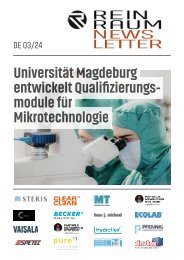Newsletter_03-2024_EN
In a quickly developing sector current information is especially important. On the one hand reinraum online offers interested persons the possibility to inform themselves comprehensively about current topics in the cleanroom branch. On the other hand companies and interested persons can use the platform to publish scientific reports, articles and company news. An event calendar complements the information offered. The ExpertPool helps with the advanced search: WHO is doing WHAT in cleanrooms. INTERNET:Current information is published daily/promptly on the internet on www.reinraum.de. NEWSLETTER: At the beginning of the month an interesting selection of the articles of last month is mailed as NEWSLETTER to all subscribers. NEWSFLASH: Between the monthly newsletters current information is sent via our NEWSFLASH to all subscribers. YEARBOOK: In January all selected articles of the last year are summarized in the CLEANROOM YEARBOOK.
In a quickly developing sector current information is especially important. On the one hand reinraum online offers interested persons the possibility to inform themselves comprehensively about current topics in the cleanroom branch. On the other hand companies and interested persons can use the platform to publish scientific reports, articles and company news.
An event calendar complements the information offered.
The ExpertPool helps with the advanced search: WHO is doing WHAT in cleanrooms.
INTERNET:Current information is published daily/promptly on the internet on www.reinraum.de.
NEWSLETTER: At the beginning of the month an interesting selection of the articles of last month is mailed as NEWSLETTER to all subscribers.
NEWSFLASH: Between the monthly newsletters current information is sent via our NEWSFLASH to all subscribers.
YEARBOOK: In January all selected articles of the last year are summarized in the CLEANROOM YEARBOOK.
Create successful ePaper yourself
Turn your PDF publications into a flip-book with our unique Google optimized e-Paper software.
Advances in biotechnology, artificial intelligence, and surgery are transforming<br />
healthcare. This new era is marked by enhanced safety, improved accuracy,<br />
and greater personalization.<br />
From Telesurgery to 3D Bioprinting: Five<br />
Emerging Technologies Poised to Reshape<br />
Medical Treatment<br />
Technological advances are revolutionizing healthcare, improving<br />
patient access to personalized care and ensuring clinicians adhere<br />
to evidence-based guidelines. This transformation is leading to enhanced<br />
patient safety. Here are five medical innovations involving<br />
the latest tech, all with the potential to redefine healthcare.<br />
1. Telesurgery: the next leap in remote medical care<br />
Remote surgery, also known as “telesurgery,” makes it possible<br />
for a surgeon to perform an intricate operation from miles away,<br />
even from the other side of the world. This is done through a combination<br />
of advanced robotics and high-speed data connections. With<br />
this technology, surgeons can guide robotic instruments remotely,<br />
bringing expert surgical care to patients no matter where they are in<br />
the world.<br />
This technology is already being used for minimally invasive procedures<br />
like knee and hip replacements, but research is ongoing for<br />
its potential use in neurosurgery and spine procedures as well.<br />
2. 3D-Printed Organs: personalized solutions for<br />
transplant patients<br />
In the not-too-distant future, 3D bioprinting could bring an end<br />
to the era of long transplant waiting lists, offering personalized solutions<br />
to patients in urgent need of organ replacement. This innovative<br />
technology creates biological tissues and organ structures one<br />
layer at a time, employing a process similar to traditional 3D printing<br />
but using living cells — often called “bio-ink” — as the raw material.<br />
Since bio-ink is derived from the recipient’s cells, the body is<br />
more likely to accept the transplanted tissues as a part of itself, making<br />
lifelong immunosuppressive therapy less necessary. While fullscale<br />
3D-printed organs are still a couple of decades away, biotech<br />
firms like Vital3D are developing technologies to enhance the speed<br />
and precision of 3D bioprinting, making strides toward a future where<br />
organ scarcity is no longer an issue.<br />
(Photo credit: freepik)<br />
3. Nanomedicine: harnessing the power of the microscopic<br />
Nanomedicine is an innovative field of medical research in<br />
which nano-sized tools are used to navigate the body in ways<br />
previously unimaginable, targeting particular cells for treatment.<br />
One area where nanomedicine shines is in targeted drug delivery.<br />
Whereas traditional medication can affect both sick and healthy<br />
cells, nanoparticles can be designed to deliver drugs precisely to<br />
the diseased cells, minimizing side effects and boosting treatment<br />
efficacy.<br />
As research progresses, the application of nanomedicine has the<br />
promise to become a cornerstone in the future of minimally invasive<br />
treatments, providing a powerful tool in the fight against some of the<br />
most challenging diseases.<br />
4. CRISPR technology: revolutionizing genetic medicine<br />
A gene-editing technology known as CRISPR allows scientists<br />
to target specific segments of genetic code and replace or modify<br />
them with pinpoint accuracy. This technology is being developed at<br />
biotech firms around the world, including the Lithuania-based Caszyme,<br />
a startup that specializes in providing research services for<br />
CRISPR applications and creating new CRISPR-based molecular<br />
tools.<br />
Using such tools, researchers are making considerable headway<br />
in addressing health conditions like sickle cell anemia, congenital<br />
blindness, and heart disease at the genetic level. As ethical debates<br />
and research progress, CRISPR stands as one of the most groundbreaking<br />
and contentious medical technologies in modern science.<br />
5. Artificial intelligence in diagnosis and treatment<br />
Artificial Intelligence (AI) could improve the medical landscape<br />
at both administrative and diagnostic levels. AI’s capacity to sift<br />
through millions of scientific papers and patient records increases<br />
the ability of hospitals and physicians to dramatically improve patient<br />
care. For example, the startup Oxipit has developed AI solutions<br />
to help radiologists analyze medical images, lowering error rates and<br />
improving patient outcomes.<br />
The University of California, Irvine is also using AI-based tools<br />
to help doctors read brain scans of stroke victims, helping speed up<br />
the diagnosis and treatment processes in situations where time is of<br />
the essence. The integration of AI within healthcare is ongoing, and<br />
with each advancement, it promises not only to enhance the quality<br />
of care but also to substantially reduce healthcare costs, making cutting-edge<br />
medical services accessible to a broader population.<br />
Vital3D<br />
10224 Vilnius<br />
Lithuania<br />
www.reinraum.de | www.cleanroom-online.com NEWSLETTER | Edition <strong>EN</strong> <strong>03</strong>-<strong>2024</strong><br />
page 10/33
















